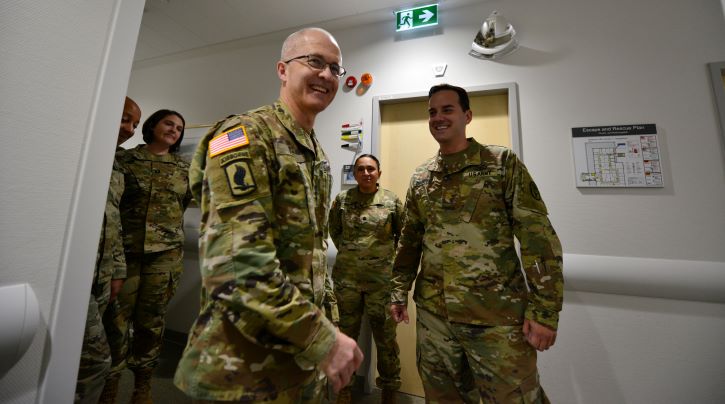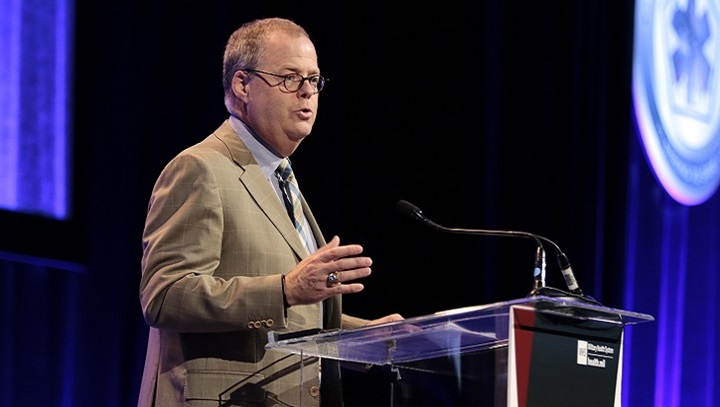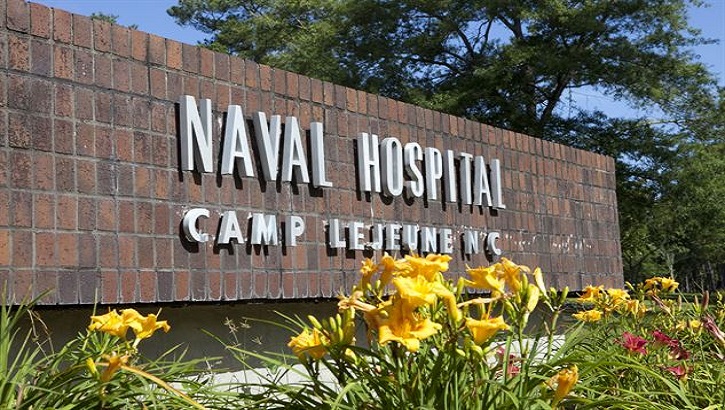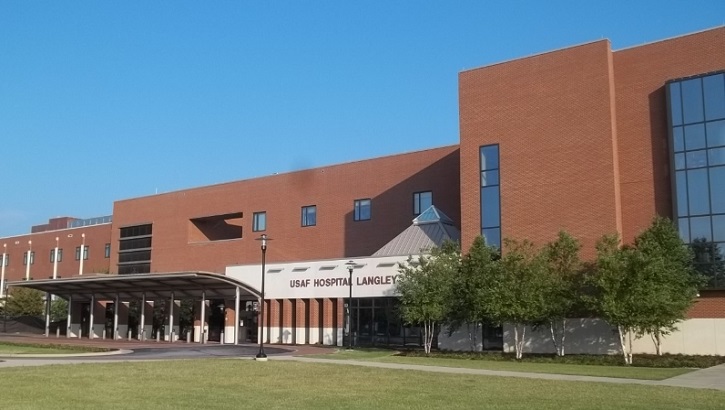
DHA Director discusses vision for future

Lt. Gen. Ronald Place, Director, Defense Health Agency, visits with the staff of the Stuttgart Army Health Clinic in Germany. Since becoming DHA Director, Lt. Gen. Place has focused on creating great outcomes for the beneficiaries who rely on the Military Health System for their health care.
Since Lt. Gen. Ronald Place became Director of the Defense Health Agency on September 3, 2019, his focus has been great outcomes for the men and women who rely on the Military Health System for their health care. At a time of unprecedented reform in military medicine, DHA is providing a more integrated system of readiness and health in support of the National Defense Strategy. Health.mil sat down with Place to discuss his initial impressions as director and his vision for the DHA. This format has been condensed and edited for clarity.
Health.mil: It's been four months since you became the DHA Director. How would you characterize this time so far?
LTG Place: It's been extraordinarily exciting. Every job that you get is a little bit different than what you expected and that's no different from this particular job. The thing that surprised me the most, really, was the depth and complexity of the entire mission set of the Defense Health Agency.
I thought I had a pretty good idea of what it was, based on my time working as a program management officer for the NDAA 2017, being the Director of DHA’s National Capital Region Medical Directorate, then interim Assistant Director for Health Care Administration. But despite all that experience, it still surprised me just how much there was. What I wasn't surprised by was the dedication, expertise, patriotism, and passion of the DHA staff.
Health.mil: One of your first actions was publishing your four priorities for the DHA: Great Outcomes, a Ready Medical Force, Satisfied Patients, and a Fulfilled Staff. Can you explain how these are connected?
LTG Place: Great Outcomes reflect the first mission in the Military Health System: to make sure that every service member is medically ready to do their job, then using that knowledge and expertise for all beneficiaries. “Ready Medical Force” really means we have to have deployable medical TEAMS – surgical teams, preventive medicine teams, dental teams, etc., across the entire spectrum. We have to be able to project that far forward, and then take care of whatever medical mission sets that are there. So it’s pretty easy to see how the first two priorities are related.
When it comes to “Satisfied Patients,” that means we deliver on all elements of the health care system such that when patients think about getting health care within the Military Health System or somewhere else, they think, “Oh, absolutely yes in the MHS!” This also means taking into account patient-related or patient-reported outcome measures.
Finally, “Fulfilled Staff” matters in that our entire team chose the health care field for a reason: so we can make a difference. Medicine is interesting, challenging, and rewarding, and it's different every day. But the bottom line is: are we making a difference?
So, how are we making a difference? How are we fulfilling ourselves? How can we build teams to collectively deliver medical readiness to our force? How can we build our teams so they are ready to deploy? How can we do it in such a way that when people talk about the Military Health System, they say, “Wow, this is great health care!” Who doesn't want to work in an environment like that? If we do all those things well, and think about our staff while we're doing it, the fulfillment of each individual employee – uniformed member, civilian, and contract – should fit into that. Then, the people who come into our system should think: “That's the greatest system ever. That's where I want to work.” That's why I see them as related.
Health.mil: What examples can you share where DHA is taking a patient-centered approach as it becomes more integrated?
LTG Place: The easiest examples are things I describe as patient-facing administrative functions. The things we do at each installation should be the same, and yet they're different almost everywhere. Why isn’t making appointments the same everywhere, whether they’re appointments within a primary care clinic on the installation or referrals to specialty care off the installation? It should be the same. That’s going to be a really hard thing to standardize, but it's an important thing for us to do.
Simpler, perhaps, are laboratory or pharmacy functions. When our patients use our laboratories or pharmacies, the process they use should be standardized. No matter where they move across the world, they're familiar with our system. They just walk in and say: “This is comfortable to me.” Those are the things I focus on. Yes, patient-facing. Yes, patient-focused. Yes, make it easier for them.
Health.mil: As Military Treatment Facilities transition from the Services to DHA, the next steps are to establish the functions and management structures at DHA headquarters to support the MTF operations and markets. Can you talk about the progress so far? What are the next steps in that process?
LTG Place: As of early January 2020, the majority of the functional capabilities were organized so that the DHA headquarters could support the small number of markets and MTFs that the DHA is currently responsible for. Similarly, the DHA conducted a Command Post Exercise where we challenged ourselves with urgent, but relatively typical functions that an operational headquarters would have to do to support direct reporting markets. That particular Command Post Exercise worked out relatively well for a couple of reasons. First, it showed that the headquarters really could function as a health care supporting headquarters. Second it pointed out some challenging areas that we really hadn't thought through or developed processes for. It highlighted how important it is to have both the number of staff and particular expertise to do something. So that Command Post Exercise was very useful.
The final part is certifying the markets, with the National Capital Region market, the Central North Carolina market, the Jacksonville market, and the coastal Mississippi market standing up first. We're in a good place when it comes to the first parts of the transformation of the Defense Health Agency to an operational headquarters managing MTFs and markets. That said, there's still a long way to go.
Health.mil: Can you give an example of something you discovered during the Command Post Exercise that needed to be fixed?
LTG Place: Sure. One of the things that the Service medical headquarters are very good at is responding quickly when an urgent event happens. They have a functional capability – a current ops capability – that takes that information and effectively moves it into the rest of the staff to be able to respond to it. The Defense Health Agency didn’t have a “current operations” function. We had individual staff sections that worked a problem and then answered back over time. We were relatively slow but very correct about it. If you're responding to markets or responding to MTFs, speed matters.
Health.mil: As you travel to MTFs, what are some common themes you're hearing from staff? And have you spoken to patients?
LTG Place: The most common theme is the feeling of uncertainty, of not really knowing where this Military Health System transformation is going. I understand how frustrating that can be. I think the challenge is keeping up with all the changes. If you look at a system that's changing an entire baseline electronic health record, that's a huge change and it impacts in multiple ways. If you look at how we're coming together with this transformation of service MTFs into markets and DHA responsibilities – that’s a huge transformation. If you look at the Defense Department's decision to decrease the number of uniformed medical staff and potentially increase the number of civilian staff, or rely more on the managed care support contractor, that's a huge change. If you look at the responsibilities of each individual MTF and what its scope of practice ought to be and potential changes, that's a significant change. When you put all that together, the totality of unknowns for our patients and staff is enormous. I think our challenge as leaders within the Military Health System is to effectively communicate what's happening, why it's happening, and what it means for individual members of our team.
I do talk to patients, but not as much as I talk to the staff. There are lots of ways our patients give us comments about what they think, and it's important for the leaders of the individual MTFs to get the patient feedback because they're the ones on the ground providing health care locally. So, while I would like to speak more with the patients at the particular locations, I'm very sure that leaders at the MTFs are provided with good input from the patients.
Health.mil: The DHA has been designated a Combat Support Agency and the combat support function has evolved over time, especially over the past year. How would you characterize DHA’s supporting role to the Combatant Commanders and the Services?
LTG Place: Among all of the functions and all the responsibilities DHA has, combat support is the one that's least known by people outside of the DHA, and in fact, the least known by people outside of the combat support staff within the DHA. That said, it's an incredibly powerful capability.
For example, the Army did great work as the executive agent for the Joint Trauma System. However, without integrating it into the capabilities of the joint staff, without rationalizing process and policy within some sort of overarching document, without a great way to provide feedback into all aspects of the education and training systems that we have, it was incompletely leveraged. That's not to say that the Army couldn't have done that or even wouldn't have done that had they continued to be responsible for the JTS. But the fact is that once it became part of the DHA, all that did happen. Secondly, we have the ability to integrate our requirements – both our medical readiness and ready medical force requirements – in support of the Combatant Commands. We have liaison officers with direct access to the COCOM surgeons, and those COCOM surgeons have direct access to the policy arm of the Defense Health Agency, which provides synergy to the support we provide the operational warfighter. Those are just a couple of examples showing how a small but powerful interaction can mean great things for our operational brothers and sisters.
Health.mil: The civilian work force has voiced concerns regarding their jobs and how they may or may not change as MTFs transition from the Services to the DHA. What are you doing to address their concerns?
LTG Place: If I was in their shoes, I think I'd be wondering about the same things. The DHA has no interest in eliminating staff positions. We fully recognize the great work that the civilian employees at the MTFs are doing. Our responsibility is to transition them from Department of the Navy, Department of the Air Force, and Department of the Army civilians to Department of Defense civilians. Now, in most cases that means everything associated with their job transitions with them into this new position, but there may be some differences. For example, we believe in standardized position descriptions. And while the Services have some standardized positions, DoD standardized positions may be a bit different. So we have to be able to work through the differences.
Health.mil: So do you think having the same position descriptions across the MHS will allow civilian employees – some of whom are spouses of military members, who move more often – to work in other facilities more easily? To move around more easily?
LTG Place: Absolutely yes! But even further, it makes it easier to move around in a market, between facilities in a geographic area. You mentioned spouses of service members, but even if you're a retiree or family member, and you just want to move, standardized position descriptions will make it easier.
Health.mil: We hear a lot about “readiness.” How do you define readiness?
LTG Place: Readiness is defined by the Services. Whether it's the readiness of an individual Soldier, Sailor, Airman, or Marine, the Services set the requirements. Our responsibility is to turn the readiness requirement into actionable results that lead to a fully functional Airman, Marine, Soldier, or Sailor. We're going to implement the requirements that come from the Services.
Similarly, when it comes to a ready medical force, we don't set the requirements. Now when it comes to the licensing and certifications, we’ll set those requirements to work inside our facilities. But the Services will set the requirements for what it means to be an expeditionary respiratory therapist or an expeditionary intensive care unit nurse, etc. Our job within the Defense Health Agency is to provide a working environment that enables each of those staff members to be ready to do that job.
Health.mil: You’ve said you’re looking to go beyond data to learn about the successes of our work. Can you explain what you mean and what success looks like?
LTG Place: We typically have a bunch of metrics to measure how effectively we deliver a particular kind of health care, and we have all kinds of different metrics that judge the quality of the care we deliver. But those are physician- or medicine-generated requirements.
We should have patient-generated requirements, too. What does it feel like to go through the system? How well do they think they’re being treated? If we're doing some sort of therapy and the therapy ends up as bad as or worse than a particular disease, then our metrics may look good, but from the patient’s perspective, it feels terrible.
Success for a satisfied patient means that no matter what the particular medical condition is, how relatively minor or how incredibly complex, at the end of it, they are left thinking, “Thank God I'm getting my medical care in the Military Health System.”
Health.mil: Looking forward, what guidance do you have for the MTF and the DHA workforce in 2020 as MHS Transformation efforts progress?
LTG Place: The DHA workforce needs to adjust our collective mindset. We've largely been an agency that is a legacy of TMA – TRICARE Management Activity – and we're very good at that. We're very good at carefully and slowly looking at information and coming up with the right answer. That mindset doesn’t work as we support hospitals, medical centers, and clinics in action. When a question arises, we need to respond quickly.
We have to transition from being good at thoughtful, deliberate work, to also being an organization of action that takes in information and rapidly gets the right people involved. We still have to be absolutely accurate managing the TRICARE benefit, but we have to be nimble, agile, flexible, and supportive on the Direct CareDirect care refers to military hospitals and clinics, also known as “military treatment facilities” and “MTFs.”direct care delivery side. So, in our culture, we have to transition to balancing both of those things.
MHS Minute February 2020
Video
2/25/2020

Thanks for tuning in to the MHS Minute! This month, we highlight a historical moment in #MilitaryHealth history, as Defense Health Agency (DHA) established the first four health care markets in the military medical enterprise. We also take a look at the Military Health System (MHS) response to Novel Coronavirus -- learn more about what Madigan Army Medical Center is doing to combat the threat of illness by going to mamc.health.mil.
Department Of Defense Health Affairs Media Roundtable Announcement of NDAA 2017, Section 703(d) Report to Congress
Congressional Testimony
2/19/2020
Thomas McCaffery, Assistant Secretary Of Defense For Health Affairs; Dr. David Smith, Reform Leader For Health Care Management; and Lieutenant General Ronald Place, Director, Defense Health Agency, participated in a Health Affairs Media Roundtable following the announcement that the NDAA 2017, Section 703(d) Report was submitted to Congress.
McCaffery announces upcoming changes to military hospitals, clinics
Article
2/19/2020

McCaffery emphasized DoD's priority is to focus on wartime readiness while ensuring continued beneficiary access to quality health care
DoD to restructure 50 hospitals, clinics to improve readiness
Article
2/19/2020

The restructuring effort focused on strengthening the prime responsibility of military medical facilities for training medical personnel
Careful, deliberate changes ahead for select MTFs
Article
2/19/2020

The DoD’s top health official shared plans to restructure 50 military hospitals and clinics, emphasizing changes will prioritize the warfighter and force readiness
Naval Branch Health Clinic (BHC) Earle Vol 1
Report
2/18/2020
The table below summarizes the findings and data informing the decision on the future of the Military Medical Treatment Facility (MTF).
Branch Health Clinic (BHC) Colts Neck Earle Vol 2
Report
2/18/2020
The table below summarizes the findings and data informing the decision on the future of the Military Medical Treatment Facility (MTF).
Russell Collier Health Clinic, Charles Thomas Moore Health Clinic, Building 36000 Vol 1
Report
2/18/2020
The table below summarizes the findings and data informing the decision on the future of the Military Medical Treatment Facility (MTF).
Naval Branch Health Clinic (BHC) Earle Vol 2
Report
2/18/2020
The table below summarizes the findings and data informing the decision on the future of the Military Medical Treatment Facility (MTF).
Russell Collier Health Clinic, Charles Thomas Moore Health Clinic, Building 36000 Vol 2
Report
2/18/2020
The table below summarizes the findings and data informing the decision on the future of the Military Medical Treatment Facility (MTF).
Naval Health Clinic Corpus Christi Vol 1
Report
2/18/2020
The table below summarizes the findings and data informing the decision on the future of the Military Medical Treatment Facility (MTF).
Farrelly Health Clinic (FHC) Vol 1
Report
2/18/2020
The table below summarizes the findings and data informing the decision on the future of the Military Medical Treatment Facility (MTF).
Farrelly Health Clinic (FHC) Vol 2
Report
2/18/2020
The table below summarizes the findings and data informing the decision on the future of the Military Medical Treatment Facility (MTF).
Naval Health Clinic Corpus Christi Vol 2
Report
2/18/2020
The table below summarizes the findings and data informing the decision on the future of the Military Medical Treatment Facility (MTF).
Fillmore Army Health Clinic (AHC) Vol 1
Report
2/18/2020
The table below summarizes the findings and data informing the decision on the future of the Military Medical Treatment Facility (MTF).





















.jpg)









No hay comentarios:
Publicar un comentario